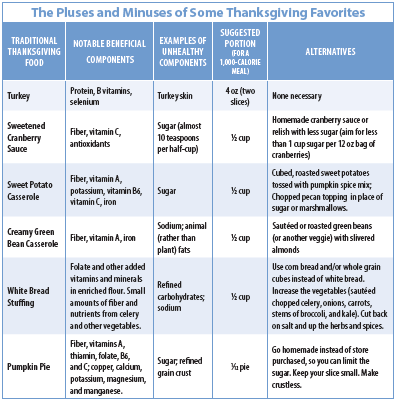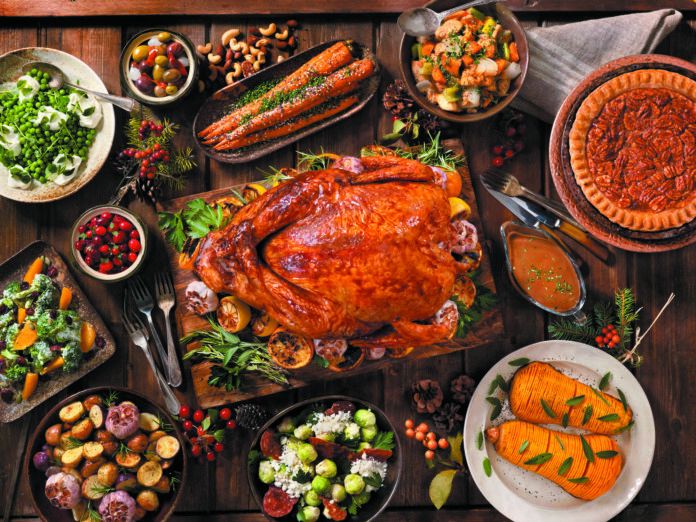Mashed potatoes, stuffing, sweet potatoes, casseroles, turkey, gravy, cranberry sauce, creamy green beans, pies and more pies…it can be confusing to determine which traditional Thanksgiving foods support good health. While one day of splurging will not ruin the benefits of an otherwise healthy dietary pattern, approaching the annual feast armed with knowledge and a plan can help you enjoy your favorites, maximize the good, and reduce any guilt (and heartburn) that may follow.
The Healthy Foods Spectrum. When we talk about how “healthy” a food is (or is not), we are talking about the combination of nutrients, processing, and other characteristics that particular food provides and how these influence the body. Whether or not a food or beverage is “good for us” depends on the balance of these positives and negatives, what other food or beverage it is being compared to, and how it fits into your overall dietary pattern. Leafy greens, for example, are packed with beneficial bioactive compounds like vitamins, minerals, and fiber, but if they are cooked with a large amount of blood-pressure-raising salt, they become a less healthy choice. Dressing a salad of these greens with plant oil, on the other hand, increases healthy fat intake and your ability to absorb certain vitamins.
Whole and minimally processed fruits, vegetables, nuts, seeds, legumes, whole grains, herbs and spices, yogurt, and seafood are on the “healthy” end of the spectrum. Dishes that feature these ingredients will be healthier choices than those that are made predominantly of refined flour and/or have high amounts of added sugar or salt.
The healthfulness of a given food also depends on how it compares to other foods. For example: High intake of refined carbohydrates and added sugars is clearly associated with increased risk for cardiometabolic diseases. A piece of apple pie is made up primarily of these unhealthy ingredients, but it also has the vitamins, minerals, and fiber from the apples. Apple pie is not a “health food,” but it might rank a bit higher than, say, white bread or a sugar sweetened beverage.
One can use this idea of a “healthy foods spectrum” to make dietary choices that are better, even if they are not the best. “Cranberry sauce and pumpkin pie are often loaded with added sugar,” says Dariush Mozaffarian, MD, DrPH, dean for policy at the Friedman School and editor-in-chief of Tufts Health & Nutrition Letter, “but they actually have more beneficial bioactive compounds and fiber from the fruit than white potatoes and bread.” Be careful to keep things in perspective: the fiber, vitamins, and minerals in a piece of pumpkin pie make it a better choice than some foods, but it doesn’t come close to the healthfulness of a piece of fruit or roasted vegetable.

What to Do. Thinking of foods as being on a healthfulness spectrum can help you make better choices from the options on the table. You can also use the concept of a healthy foods spectrum to make traditional dishes a little healthier: Make those sweet potatoes with less sugar and top with pecans instead of marshmallow; use crunchy slivered almonds instead of crispy fried onions on the green beans; add extra veggies to that stuffing (and use corn bread and/or whole wheat bread in place of the white bread cubes); add herbs and spices in place of some salt; and cook with plant oils instead of butter. Consider baking crustless pies and using oats and chopped nuts for a crunchy topping. If tweaking a less-than-healthy familiar favorite would detract from the joy and comfort it brings, manage your portion size instead. Focus on your favorite dishes that you rarely get on other days of the year or those you enjoy the most. An additional strategy is to load your plate first with salad, roasted veggies, baked squash, and other healthy dishes—and then add a few of the less healthy options. You are not the only one trying to watch what you eat this holiday season. If you are preparing the meal or bringing a dish to a gathering, a healthy—or healthier—option is likely to be much appreciated (even if it’s not 100 percent traditional).
- Use the Spectrum: make better choices, even if they are not the best.
- Make dishes a little healthier: Use the concept of a healthy foods spectrum to tweak traditional favorites.
- Don’t overindulge: Take small portions and eat mindfully, chewing slowly and savoring the taste. Pay attention to your body’s signals that you have had enough and save that second helping for another day.
- Choose thoughtfully: Consider skipping the dishes on the table that are less special to you.
- Offer alternatives: There are likely others who would appreciate healthy—or healthier—options.
Remember, an occasional splurge does not ruin an otherwise healthy dietary pattern. You can get back on track the next day.
























